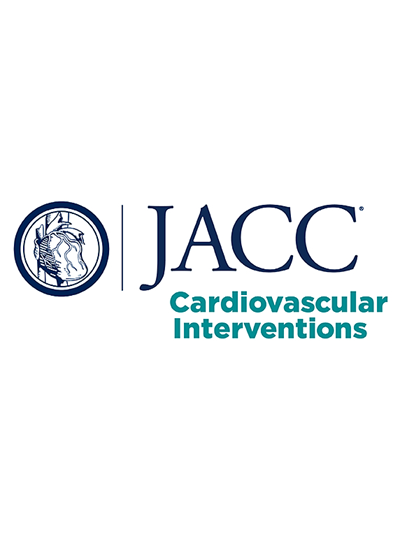系列疾病中分流储备与瞬时波自由比的随机比较
IF 11.7
1区 医学
Q1 CARDIAC & CARDIOVASCULAR SYSTEMS
引用次数: 0
摘要
血流储备分数(FFR)和瞬时无波比(iFR)可识别从经皮冠状动脉介入治疗(PCI)中获益的动脉。回拉时的FFR或iFR梯度常用于预测生理结果(FFRΔ或iFRΔ),但这种方法未经验证。目的:本研究的目的是比较FFRΔ、iFRΔ和FFRcalc(包含病变之间相互作用的数学解)预测连续性或弥漫性疾病pci后生理的准确性。方法在同一血管中有局灶性靶病变和第二局灶性病变或弥漫性病变节段的患者随机分为FFR和ifr引导的PCI (ISRCTN18106869)。进行FFR和iFR回拉,操作人员对一种模式不知情。靶病变PCI后,重新测量FFR和iFR。主要终点是pci术后生理预测值与实际值的误差。结果87例患者随机分为FFR组(n = 45)和iFR组(n = 42)。基线时的中位FFR和iFR分别为0.70 (Q1-Q3: 0.62至0.78)和0.81 (Q1-Q3: 0.68至0.90),目标病变PCI后的中位FFR和iFR分别为0.82 (Q1-Q3: 0.74至0.87)和0.89 (Q1-Q3: 0.83至0.93)。FFRΔ的预测误差为12% (6% ~ 17%),4% (0% ~ 9%);P & lt;0.001)为iFRΔ, - 5%(- 18%至8%;P = 0.427)。36%的FFRΔ病例、34%的iFRΔ病例和14%的FFRcalc病例未发现显著残留病变。结论ffr和iFR回拉梯度高估了目标病变PCI的益处,三分之一的患者可能会遗漏残余缺血。系列疾病患者pci术后应常规重复FFR或iFR。本文章由计算机程序翻译,如有差异,请以英文原文为准。
Randomized Comparison of Fractional Flow Reserve and Instantaneous Wave Free Ratio in Serial Disease
Background
Fractional flow reserve (FFR) and the instantaneous wave-free ratio (iFR) identify arteries that benefit from percutaneous coronary intervention (PCI). FFR or iFR gradients on pullback are often used to predict the physiological result (FFRΔ or iFRΔ), but this approach is unvalidated.
Objectives
The aim of this study was to compare the accuracy of FFRΔ, iFRΔ and FFRcalc (a mathematical solution incorporating interaction between lesions) for predicting post-PCI physiology in serial or diffuse disease.
Methods
Patients with a focal target lesion and either a second focal lesion or a diffusely diseased segment in the same vessel were randomized to FFR- vs iFR-guided PCI (ISRCTN18106869). FFR and iFR pullbacks were performed, with operators blinded to one modality. Following target lesion PCI, FFR and iFR were remeasured. The primary outcome was the error in predicted post-PCI physiology compared with actual values.
Results
A total of 87 patients were randomized to FFR (n = 45) or iFR (n = 42). Median FFR and iFR were 0.70 (Q1-Q3: 0.62 to 0.78) and 0.81 (Q1-Q3: 0.68 to 0.90) at baseline and 0.82 (Q1-Q3: 0.74 to 0.87) and 0.89 (Q1-Q3: 0.83 to 0.93) after target lesion PCI. The predictive errors were 12% (6% to 17%) for FFRΔ, 4% (0% to 9%; P < 0.001) for iFRΔ, and −5% (−18% to 8%; P = 0.427) for FFRcalc. Significant residual disease was missed in 36% of cases with FFRΔ, 34% with iFRΔ, and 14% with FFRcalc.
Conclusions
FFR and iFR pullback gradients overestimate the benefit of target lesion PCI and can miss residual ischemia in one-third of patients. FFR or iFR should be routinely repeated post-PCI in serial disease.
求助全文
通过发布文献求助,成功后即可免费获取论文全文。
去求助
来源期刊

JACC. Cardiovascular interventions
CARDIAC & CARDIOVASCULAR SYSTEMS-
CiteScore
11.60
自引率
8.80%
发文量
756
审稿时长
4-8 weeks
期刊介绍:
JACC: Cardiovascular Interventions is a specialist journal launched by the Journal of the American College of Cardiology (JACC). It covers the entire field of interventional cardiovascular medicine, including cardiac, peripheral, and cerebrovascular interventions. The journal publishes studies that will impact the practice of interventional cardiovascular medicine, including clinical trials, experimental studies, and in-depth discussions by respected experts. To enhance visual understanding, the journal is published both in print and electronically, utilizing the latest technologies.
 求助内容:
求助内容: 应助结果提醒方式:
应助结果提醒方式:


